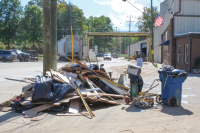Film looks at the disappearing American Chestnut
On Monday, Aug. 19, the series “Where We Live: History, Nature, and Culture,” will present a screening of the film, “Clear Day Thunder: Rescuing the American Chestnut.”
See the American chestnut story in film
Experience the story of the American chestnut, a mighty wonder that once sustained all forms of life in the Appalachian Mountains, with a film screening at 6 p.m. Thursday, Jan. 25, at the Jackson County Public Library in Sylva.
Restoring a giant: EBCI partners to resurrect the chestnut tree
Rex Mann’s father was the kind of storyteller whose voice would make everyone in the room stop what they were doing, come and listen.
Cataloochee Ranch announces tours of experimental American chestnut orchard
 In contrast to its peaceful and stunning high-mountain setting, Maggie Valley’s Cataloochee Ranch has been at the forefront of a battle — a battle to restore the American chestnut, the iconic Appalachian tree devastated by blight in the mid-20th century. In 2007, working in partnership with The American Chestnut Foundation (TACF), Cataloochee Ranch became the host site of a test orchard of potentially blight-resistant American Chestnut trees, and starting this week, they will open this orchard to the public for tours.
In contrast to its peaceful and stunning high-mountain setting, Maggie Valley’s Cataloochee Ranch has been at the forefront of a battle — a battle to restore the American chestnut, the iconic Appalachian tree devastated by blight in the mid-20th century. In 2007, working in partnership with The American Chestnut Foundation (TACF), Cataloochee Ranch became the host site of a test orchard of potentially blight-resistant American Chestnut trees, and starting this week, they will open this orchard to the public for tours.
Cataloochee Ranch commemorates the chestnut tree
Come celebrate the return of the great American chestnut tree Saturday, Sept. 10, at Cataloochee Ranch outside Maggie Valley.
This second-annual event features live bluegrass music by Hazel Creek, clogging demonstrations, crafts (including wood-turned bowls, pine needle baskets, stained glass, handcrafted wooden benches, pottery and paintings), and a tour of one of the American Chestnut Foundation’s most successful research orchards, located on the ranch grounds.
For centuries, the American chestnut was the dominant tree of the Appalachian Mountains from Maine to Mississippi. It was a fast-growing deciduous hardwood that reached 150 feet in height and 10 feet in diameter. But, in 1904, a deadly airborne fungus was introduced into the United States; by 1949, nearly four billion chestnut trees were lost.
Cataloochee Ranch is helping the American Chestnut Foundation bring back this tree, borrowing genetic code from the Chinese chestnut, which is blight resistant. By using the backcross method, researchers are working on a new tree that has just enough of the Chinese variety to be blight-resistant, but has the dominant characteristics of the original American chestnut. The ranch’s chestnut orchard is in its fifth growing season.
Tickets for the event are $10, and children 12 and under will be admitted free.
The night before, on Friday, Sept. 9, a fundraising dinner with entertainment and live auction will be held beginning at 6 p.m. Tickets to the steak dinner are $80 per person, or $120 per couple, which includes a one-year membership to the American Chestnut Foundation.
828.926.1401 for dinner reservations. For more information about Chestnut Saturday, call Richard Coker at 828.926.1345.
Cataloochee Ranch plants seed for mighty tree to thrive once more
A collaborative effort between The American Chestnut Foundation and the Coker family has put Cataloochee Ranch in Maggie Valley on the frontlines of the effort to reintroduce a tree that was integral to life of early settlers in Western North Carolina.
Before a devastating airborne disease arrived on U.S. soil in the early part of the 20th century, the American chestnut tree ruled more than 200 million acres of woodlands that stretched the length of the Appalachian Mountains. An estimated four billion American chestnuts grew in that range, nearly a quarter of the entire hardwood population.
The Chestnut blight—a fungus that enters the bark of damaged trees—came to the country on ornamental Chinese chestnuts. Durning the first half of the century, it wiped out nearly the entire population of American chestnuts, which had no inborn resistance to the disease.
Since 1989, The American Chestnut Foundation, a group founded by prominent plant scientists, has been working to create a blight-resistant strain of trees that retains the characteristics of the American chestnuts that once ruled the Eastern Woodlands — but has just enough of the Chinese chestnut strain to make it blight resistant. The effort began at the Foundation’s experimental farm in Meawdowbrook, Va., but as the scientists began to develop the third generation of their crossed trees, they also branched out to satellite farms that could represent the diverse terrain and climate characteristics of the American chestnut’s historic territory.
For Judy Coker, who grew up at Cataloochee Ranch when giant chestnuts still loomed on the hillsides, being involved in the reintroduction effort is special.
“It’s something you could call almost romantic,” She said. “You remember it in the past and you have all your hopes built up on the future. To be a part of it is really important.”
Judy Coker, known to most as Miss Judy, has been on the board of The American Chestnut Foundation’s Carolinas Chapter, and has passed that role on to her daughter, Judy Sutton.
In the mountains only the older generation remembers what chestnuts were like in their glory, and Miss Judy’s recollections of healthy trees are fleeting.
“The one memory I have—and I was probably 6 years old—was going to the Purchase, which is a huge open pasture,” Miss Judy said. “I remember there were six huge trees in the open field, and they were spread out wide. We went to pick the chestnuts, and they were just everywhere.”
The chestnut
past and present
The American chestnut was perhaps more important to the economy of Western North Carolina than to any other area in its range. A late-flowering and extremely productive tree, immune to seasonal frosts, the American chestnut was the single most important food source for wildlife, from bears to deer to birds.
Mountain communities depended upon the annual chestnut harvest as a cash crop and as a primary source of forage for their livestock, which were turned lose in the chestnut forests to gorge themselves and fatten up before the harvest.
In addition, chestnut wood split straight and was rot resistant, making it ideal for everything from fence posts and barn frames to coffins and shingles.
“The mountain people took the chestnut for granted because it was used for everything from the cradle to the grave,” said Richard Coker, whose grandparents started Cataloochee Ranch.
Cataloochee Ranch is a rugged outdoor resort on expansive mountaintop acreage near Maggie Valley, dating to the 1930s. Even though the chestnuts were already dying, much of the ranch was built with wood from the still standing but dead trees.
In 2007, Dr. Paul Sisco, a plant geneticist and Chestnut Foundation board member, helped the Cokers plant 320 trees, representing three strains of North Carolina American chestnut stock, on a hill above the Cataloochee Ranch.
“We are a conservation business so the chestnuts just fit right into that,” Richard Coker said. “I, as well as many other people, took the chestnuts for granted. When they died we realized how important they were.”
Now 4-years-old, the trees are still two or three years away from blooming. Before they reach blooming age, which is when the blight begins to infect trees, they will be inoculated with measured doses of the disease. Unfit trees will be culled, and the resistant trees crossbred again.
Sisco said the Haywood County location and its high elevation were a perfect site for the experimental grove for both historical and biological reasons. Historically, Western North Carolina was third in the country in terms of chestnut acreage behind Pennsylvania and West Virginia, and the largest chestnut ever recorded was cut in Haywood County in Francis Cover before 1915. That giant tree measured 17 feet in diameter — or approximately 53 feet around.
“The best land for reintroduction of chestnuts is really the high mountains because it’s the best topsoil left,” Sisco said.
Mountain natives know that certain names for hills are ubiquitous. Cold Mountain, Black Mountain and Balsam Mountain are names derived from common characteristics. So, too, is the name Yellow Mountain, which Sisco said originated from chestnut covered hilltops in June, when their yellow flowers color the landscape.
The American chestnut was significant to the local economy in Haywood County even after the blight had killed the trees. According to Sisco, who has researched the tree’s uses in detail, the wood of dying trees insulated Champion Paper Company from the Depression. Until 1951, Champion operated a chestnut extract plant that used the high tannin content—up to 11 percent dry, white tannin—to process tanning agents for local tanneries.
Chestnuts are naturally resistant to frost and like well-drained soil. While Cataloochee Ranch’s 5,000 foot altitude is just at the high end of the chestnuts preferred range, the trees their have been thriving. Another benefit of the altitude is that it reduces the threat of a root rot, called phytopthora, that doesn’t do well in colder temperatures.
“We’ve had a tremendous survival rate up here,” Sisco said of the three strains planted from seed.
The American Chestnut Foundation’s backcross breeding program took Chinese chestnut trees, naturally resistant to the blight, and crossed them with their American cousins, resulting in trees that were half American and half Chinese. The offspring were backcrossed to the American species twice more to produce an American chestnut tree that retained no Chinese characteristics other than blight resistance.
The trees at Cataloochee come from three distinct North Carolina mother trees being crossed with Asian trees. There are 44 experimental chestnut orchards in Western North Carolina, but the Cokers’ is the second biggest and by far, the most visible.
Richard Coker helped put the seeds in the ground, and he said watching the seedlings grow has shown him the power of the American chestnut tree.
“I’ve learned what a dominant species they are,” Richard Coker said. “ We have 4-year-old trees that are over my head. They just love the mountaintops.”
Sisco stops short of saying that the reintroduction of the American chestnut is sure to succeed, but he said the Foundation’s scientists will continue to produce better varieties of American chestnut until they have surviving adult trees that are capable of living free.
“What’s going to happen is we are going to have better materials coming along all the time. People are just going to have to be patient,” Sisco said.
In September, the Cokers will host Chestnut Saturday at Cataloochee Ranch, a fundraiser for the Carolinas Chapter of TACF, and a national gathering of chestnut scientists.
For Richard Coker, the events will mark a milestone on the way to a monumental victory.
“I would hope that within my daughter’s lifetime the chestnuts will be free-ranging,” Richard Coker said.
For more information, go to www.acf.org.
Working to bring back the American chestnut
By Julie Ball • Correspondent
As a boy, Gene Gibson remembers his parents heading to some of Western North Carolina’s high mountain ridges in search of chestnuts.
By that time — the early 1930s — most of the trees at the lower elevations were dead, killed by a devastating chestnut blight that all but wiped out the species.
“Most of the chestnut trees down here had already died, but there were still some in the higher ridges that were still producing,” said Gibson, who lives in Jackson County.
For southern Appalachian families, the American chestnut was an important part of life. Not only did it produce food for livestock and timber for homes, but the chestnuts from these massive trees could be used to barter or to sell.
Now a modern-day effort to bring back the tree is taking an important step forward. The U.S. Forest Service, American Chestnut Foundation and officials from the University of Tennessee recently announced the planting of 500 blight-resistant trees on U.S. Forest Service land in North Carolina, Tennessee and Virginia.
The planting took place last winter, and the trees have thrived over the past year, according to forestry officials.
“Today really is a historic event,” said Bryan Burhans, president of The American Chestnut Foundation, which has been working for more than 25 years to develop a blight-resistant tree.
The foundation has been breeding the blight-resistant Chinese chestnut with the American chestnut, resulting in a mix that is genetically 94 percent American chestnut and 6 percent Chinese chestnut. The cross will hopefully provide just enough DNA from the Chinese chestnut to stave off the blight, yet still boasts the signature characteristics of the American chestnut, such as the prized nuts and high quality wood.
Roger Williams, director of forest management for the U.S. Forest Service Southern Region, called the test planting another step toward re-introducing this “keystone species” to its native range decades after it was wiped out.
Forest experiment
The chestnut seedlings planted last year have grown an average of 10 inches already.
Stacy Clark, research forester for the U.S. Forest Service Southern Research Station, described them as “healthy” and “free from blight,” but it will take several more years to determine if they are blight resistant.
Clark said the blight normally doesn’t show up until the trees are five to 10 years old.
“We are hopeful the test plantings conducted last winter will be successful,” said Barbara Crane, regional geneticist for the U.S. Forest Service Southern Region.
The 500 blight-resistant trees were among a total of 1,200 trees planted at three locations on national forest land.
The other 700 trees included pure American chestnut trees, pure Chinese chestnut trees and various generations of trees that are a mixture of the two species. The seedlings grew for a year in a nursery before they were planted as part of this effort.
“These first test plantings are true scientific experiments,” Clark said.
Officials will monitor the growth and determine whether they can survive and what kind of management might be needed.
“Also, it’s important to determine how these trees will grow in a real-world setting,” Clark said.
The Forest Service and University of Tennessee planted the trees on Forest Service land under a memorandum of understanding with The American Chestnut Foundation. The agencies are not saying exactly where the trees are planted to protect them from possible theft.
“The trees we planted are approximately 4- to 6-feet tall. They came from nuts that were collected over two years ago,” Clark said.
Plans call for another 500 blight-resistant trees to be planted in 2010 on national forest land. The American Chestnut Foundation is also working to develop a plan for future restoration of the trees. The American Chestnut Foundation recevied a $1 million contribution last year from the Stanback family, known as champions of conservation in Western North Carolina for their large contributions to preserve tracts of land.
Loss of the chestnut
The loss of the American chestnut tree was a “disaster,” according to Gibson, who lives in Jackson County.
Chestnuts made up 25 percent of the hardwood forests in the eastern U.S. The massive trees grew alongside oaks, but they produced more mast and also produced food more consistently. Burhans said a mature oak would produce 1,000 acorns on average — but a mature American chestnut tree produced 6,000 chestnuts on average.
The chestnuts were an important source of food in the forest, but they also provided a crop that could be sold by people living in the southern Appalachian region.
Gene Gibson’s son, Bill Gibson, who serves as executive director of the Southwestern Commission, said his grandmother was born in Haywood County and later lived in Jackson County. She told stories of heading to high mountain coves during the fall to collect chestnuts.
The family would bring along buckets, washtubs, and any other containers they could find. They’d also bring along livestock to fatten them up on the chestnuts.
“They (the family) would go back there, and they’d stay a long time, maybe a week or more,” Bill Gibson said.
The family would roast the chestnuts on site, then haul them home to use during the winter.
Timber from the American chestnut was also used heavily in the mountains. And Western North Carolina is full of stories about the size of the trees. In some cases, it took several people holding hands to reach around the massive trunks.
The trees contributed to the overall health of the ecosystem and were a valuable source of food for wildlife, according to Williams. But in the first half of the 20th century, the trees began dying, hit by a fungus that would become known as the chestnut blight. By the early 1950s, the American chestnut had virtually disappeared, even at the high elevations.
Sprouts from the old root systems can still be found in mountain forests, and one goal of The American Chestnut Foundation is to collect pollen from those native trees for use in the breeding process.
The foundation developed the blight-resistant trees using backcross-breeding over a number of years.





